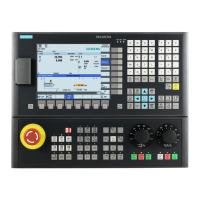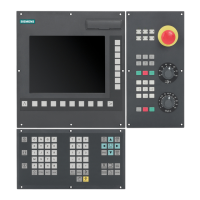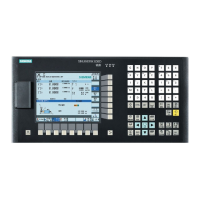M1: Kinematic transformation
6.10 Examples
Extended Functions
420 Function Manual, 03/2013, 6FC5397-1BP40-3BA1
; prepare for TRANSMIT (as first and only transformation)
$MA_ROT_IS_MODULO[3] = TRUE ; c as modulo axis
MD24100 $MC_TRAFO_TYPE_1 = 256 ;TRANSMIT transformation
MD24110 $MC_TRAFO_AXES_IN_1[0] = 1 ; channel axis perpendicular to rotary
axis
MD24110 $MC_TRAFO_AXES_IN_1[1] = 3 ; channel rotary axis
MD24110 $MC_TRAFO_AXES_IN_1[2]=2 ; channel axis parallel to rotary axis
MD24120$MC_TRAFO_GEOAX_ASSIGN_TAB_1[0]
=1
; 1. channel axis becomes GEOAX X
MD24120
$MC_TRAFO_GEOAX_ASSIGN_TAB_1[1]=3
; 2. channel axis becomes GEOAX Y
MD24120
$MC_TRAFO_GEOAX_ASSIGN_TAB_1[2]=2
; 3. channel axis becomes GEOAX Z
MD24900 $MC_TRANSMIT_ROT_AX_OFFSET_1=0 ; rotation position X-Y plane against
zero position of the rotary axis
MD24910
$MC_TRANSMIT_ROT_SIGN_IS_PLUS_1=FALSE
; Rotary axes turns
MD24920 $MC_TRANSMIT_BASE_TOOL_1 [0]=0.0 ; tool center distance in X
MD24920 $MC_TRANSMIT_BASE_TOOL_1 [1]=0.0 ; tool center distance in Y
MD24920 $MC_TRANSMIT_BASE_TOOL_1 [2]=0.0 ; tool center distance in Z
; activation TRANSMIT
; Programming in X,Y,Z
; Return to rotational operation
TRAFOOF
See also
TRACYL (Page 420)
6.10.2 TRACYL
The following figure shows an example relating to the configuration of axes and shows the
sequence of main steps required to configure the axes up to activation by TRACYL.
; General axis configuration for rotation
MD20060 $MC_AXCONF_GEOAX_NAME_TAB[0]="X" ; Geometry axis
MD20060 $MC_AXCONF_GEOAX_NAME_TAB[1]="Y" ; Geometry axis
MD20060 $MC_AXCONF_GEOAX_NAME_TAB[2]="Z" ; Geometry axis
MD20050 $MC_AXCONF_GEOAX_ASSIGN_TAB[0] = 1 ; X as channel axis 1
MD20050 $MC_AXCONF_GEOAX_ASSIGN_TAB[1] = 2 ; Y no channel axis
MD20050 $MC_AXCONF_GEOAX_ASSIGN_TAB[2] = 3 ; Z as channel axis 2

